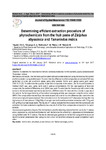| dc.description.abstract | Objective: To determine the most effective method of extracting metabolites from the two herbs Ziziphus abyssinica and
Tamaridus. Indicus.
Methodology and results: The methods used included cold and soxhlet extraction using methanol as the solvent
and hot extraction using distilled water. To determine the efficiency in which compounds are extracted TLC was
performed on silica gel aluminium plates using ethyl acetate: formic acid: glacial acetic acid: water
(100:11:11:27). To determine the quantity of phenolic compounds in the extract, the Folin and Ciocalteau’s
method (1927) was used, using Gallic acid in various concentrations. For the total quantity of flavonoid
compounds, the method of Miliauskas et al. (2004) was used. To determine the Proanthocyanidin content in the
extract a method previously reported by Ayoola et al, 2006 was used. To measure the antioxidant capacity of
the extracts the hydrogen donating or free radical scavenging activity, was measured using the stable radical
DPPH. The compounds extracted by all the methods were about seven but the difference was noted when the
individual compounds were analysed. The cold extraction on the herb extract of Z. abyssinica had significantly
high amount of total phenols 1.99g/100g of sample than both soxhlet and water extraction with 1.51g and
0.61g/100g of sample respectively. The results of T. indicus indicate that the extracts from the soxhlet and cold
extraction methods contained a significantly low amount of all the three compounds compared to the water
extracts
Conclusion and application of results: The method best suited for obtaining extracts from the two herbs T. indicus
and Z. abyssinica is, cold method of extraction with methanol as the solvent for Z. abyssinica and hot extraction
using distilled water for T. indicus. The results obtained give guidance to the fact that using both herbs would
result in a better preservative than using one herb since the identified compounds would complement each
other | en_US |

